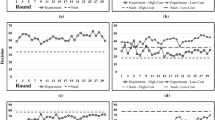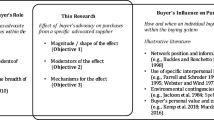Abstract
This paper reconsiders the evidence and several of the key arguments associated with the theory of supplier-induced demand (SID). It proposes a new theory to explain how ethical behaviour is consistent with SID.
The purpose of a theory of demand and one criterion for the evaluation of a theory is the provision of a plausible explanation for the observed variability in service use. We argue that Australian data are not easily explained by orthodox possible explanation. We also argue that, having revisited the theory of SID, the agency relationship between doctors and patients arises not simply because of asymmetrical information but from an asymmetrical ability and willingness to exercise judgement in the face of uncertainty. It is also argued that the incomplete demand shift that must occur following an increase in the doctor supply is readily explained by the dynamics of market adjustment when market information is incomplete and there is non-collusive professional (and ethical) behaviour by doctors. Empirical evidence of SID from six Australian data sets is presented and discussed. It is argued that these are more easily explained by SID than by conventional demand side variables. We conclude that once the uncertainty of medical decision making and the complexity of medical judgements are taken into account, SID is a more plausible theory of patient and doctor behaviour than the orthodox model of demand and supply. More importantly, SID provides a satisfactory explanation of the observed pattern and change in the demand for Australian medical services, which are not easily explained in the absence of SID.








Similar content being viewed by others
References
Dranove D. Demand inducement and the physician/patient relationship. Econ Inq 1988; 26(2): 281–98
Folland S, Goodman AC, Stano M. The economics of health and health care. New York: MacMillan, 1993
Rice T, Labelle RJ. Do physicians induce demand for medical services? J Health Polit Policy Law 1989; 14(3): 587–600
Donaldson C, Gerrard K. Paying general practitioners: shedding light on the review of health services. J R Coll Gen Pract 1989; 39: 114–7
Fuchs V. The supply of surgeons and the demand for operations. J Hum Resour 1978; 13 Suppl.: 35–56
Fuchs VR, Kramer MJ. Determinants of expenditures for physicians’ services in the United States, 1948–68. National Bureau of Economic Research Occasional Paper no. 117, DHEW Publication (HSM), National Center for Health Services Research and Development. New York: National Bureau of Economic Research, 1972
Richardson J. The inducement hypothesis: that doctors generate demand for their own services. In: van der Gaag J, Perlman M, editors. Health, economics and health economics. Amsterdam: North-Holland Publishing Co., 1981: 189–214
Cromwell J, Mitchell JB. Physician-induced demand for surgery. J Health Econ 1986; 5: 293–313
Phelps C. Induced demand: can we ever know its extent? J Health Econ 1986; 5: 355–65
Evans RG. Supplier-induced demand: some empirical evidence and implications. In: Perlman M, editor. The economics of health and medical care. New York: John Wiley and Sons, 1974
Auster R, Oaxaca R. Identification of supplier induced demand in health care sector. J Hum Resour 1981; 16: 327–42
McGuire TG. Physician agency. In: Culyer AJ, Newhouse JP, editors. Handbook of health economics. Vol. la. Amsterdam: North-Holland, 2000: 461–536
Friedson E. Patients’ views of medical practice. New York: Sage, 1961
Siminoff LA, Step MM. A communication model of shared decision making: accounting for cancer treatment decisions. Health Psychol 2005; 24(4): S99–S105
Kahneman D, Tversky A. The framing of decisions and the psychology of choice. Science 1981; 211: 453–8
Feldman-Stewart D, Brundage MD, McConnell BA, et al. Practical issues in assisting shared decision-making. Health Expect 2000; 3: 46–54
Ravdin PM, Siminoff LA, Harvey JA. Survey of breast cancer patients concerning their knowledge and expectations of adjuvant therapy. J Clin Oncol 1998; 16: 515–21
Maynard A, Bloor K. Our certain fate: rationing in health care. London: Office of Health Economics, 1998
Mooney G, Russell E, Weir R. Choices for health care: a practical introduction to the economics of health provision. London: Macmillan, 1986
Hurley J, Birch S, Stoddart G, et al. Medical necessity, benefit and resource allocation in health care. J Health Serv Res Policy 1997; 2: 223–30
Wennberg J. Improving the medical decision making process. Health Aff 1988; 7: 99–106
Oxley H, MacFarlan M. Health care reform: controlling spending and increasing efficiency. Economics Department working paper no. 149. Paris: OECD, 1994
Richardson J, Peacock S. Supplier induced demand reconsidered. Working paper no. 81. Melbourne (VIC): Centre for Health Program Evaluation, Monash University, 1999
Richardson J. The health care financing debate. In: Mooney G, Scotton RB, editors. Economics and Australian health policy. Sydney (NSW): Allen & Unwin, 1998: 192–213
Richardson J, Deeble J. Statistics of private medical services in Australia 1976. Canberra (ACT): Australian National University Printing Service, 1982. Health Research Project, Technical paper no. 1
Richardson J. Supply and demand for medical care: or, is the health care market perverse? Aust Econ Rev 2001; 34(3): 336–52
Commonwealth Department of Health and Family Services. Medicare statistics: 1984/85 to March quarter 1998. Canberra (ACT): Commonwealth Department of Health and Family Services, 1998
Australian Government Productivity Commission. Australia’s health workforce: Productivity Commission research report. Canberra: Australian Government Productivity Commission, 2005 Dec 22 [online]. Available from URL: http://www.pc.gov.au/study/healthworkforce/finalreport/healthworkforce.pdf [Accessed 2006 May 9]
Scotton R. The doctor business. In: Mooney G, Scotton RB, editors. Economics and Australian health policy. Sydney (NSW): Allen & Unwin, 1998: 72–92
Doessel DP. Is an increased medical workforce a “problem” in the health sector? Theory and evidence. In: Harris A, editor. Economics and Health 1997: proceedings of the Nineteenth Australian Conference of Health Economists. Kensington (NSW): School of Health Services Management, University of New South Wales, 1998: 99–130. Australian Studies in Health Services Administration Series no. 85
Ramsey JB, Wassow B. Supplier induced demand for physician services: theoretical anomaly or statistical artefact? An econometric evaluation of some important models in physician service markets. In: Basmann R, Rhodes G, editors. Advances in econometrics. Greenwich: JAI Press, 1986: 49–77
Robertson I, Richardson J. The effect of funding upon hospital treatment: the case of coronary angiography and coronary artery revascularisation procedures following acute myocardial infarction. Med J Aust 2000; 173: 291–5
Australian Bureau of Statistics (ABS). Australian Standard Geographical Classification (ASGC) 1999. Canberra (ACT): Australian Bureau of Statistics, 1999
Acknowledgements
The authors would like to thank the Commonwealth Department of Health and Ageing and the Victorian Department of Human Services for the data used in the empirical studies, and two anonymous referees for their comments on an earlier draft of the paper. The research was supported by a National Health and Medical Research Council (NHMRC) Project Grant. The views expressed in this paper are those of the authors, and not the funding agency.
This paper is a revised version of a working paper (Richardson J, Peacock S. Supplier induced demand reconsidered. Working paper no. 81. Melbourne (VIC): Centre for Health Program Evaluation, Monash University, 1999).
Author information
Authors and Affiliations
Corresponding author
Appendix
Appendix
1. Small Area Definitions
Small area data used in empirical analysis are based on the hierarchical structure of the Australian Standard Geographical Classification.[33] In noncensus years the classification consists of statistical local areas (SLAs), statistical subdivisions (SSDs), statistical divisions (SDs) and states/territories. Under the hierarchical structure, SLAs are aggregated to form SSDs, SSDs are aggregated to form SDs, and SDs aggregate into states and territories. These spatial units cover all of Australia without gaps or overlaps. As at 1999, there were 1331 SLAs, 194 SSDs and 66 SDs covering mainland and offshore Australian states and territories. SLAs and SSDs are based on defining regions that show social and economic homogeneity through identifiable links between inhabitants, and on local government boundaries. SDs also maintain this basis but, in addition, the capital city of each state/territory is defined as a single SD.
Rights and permissions
About this article
Cite this article
Richardson, J.R.J., Peacock, S.J. Supplier-Induced Demand. Appl Health Econ Health Policy 5, 87–98 (2006). https://doi.org/10.2165/00148365-200605020-00003
Published:
Issue Date:
DOI: https://doi.org/10.2165/00148365-200605020-00003




